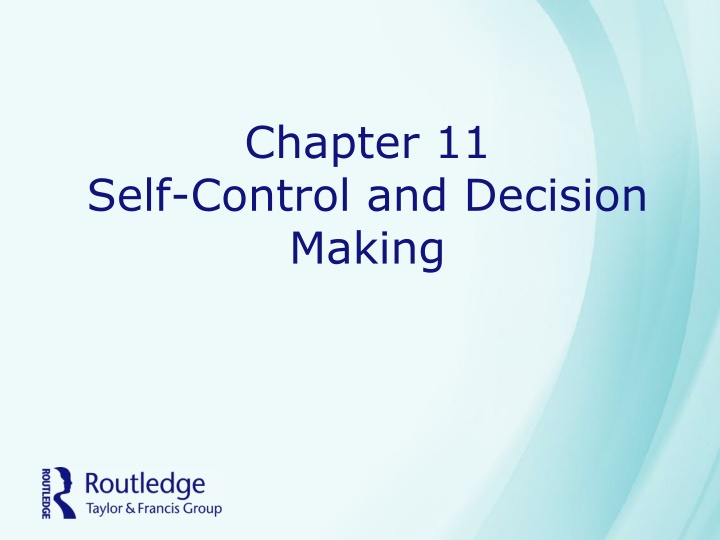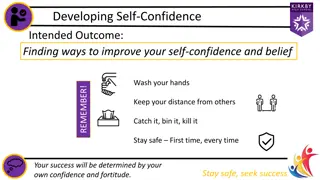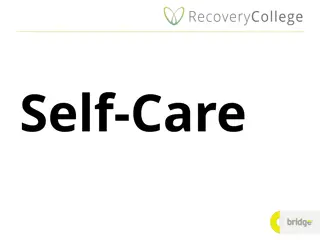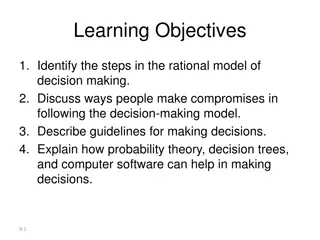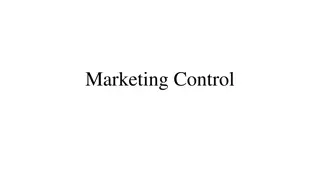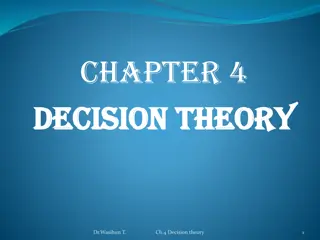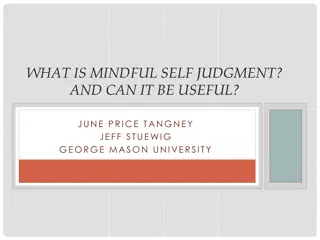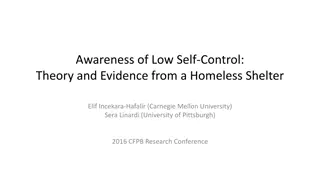Self-Control and Decision
In the realm of self-control and decision-making, individuals often find themselves torn between immediate desires and long-term goals. The battle between instant gratification and prudent planning is a universal challenge that manifests in various aspects of life, from financial investments to personal habits. This struggle is epitomized by the conflict between a "doer" who seeks immediate pleasure and a "planner" who prioritizes delayed gratification. Recognizing the power dynamics at play, individuals devise rules to reinforce willpower and resist temptation. From controlling spending impulses to making strategic retirement and investment decisions, developing self-control strategies is crucial for achieving stability and aligning actions with long-term objectives. By exploring the nuances of desire, willpower, and decision-making, one can navigate these internal conflicts and make informed choices that lead to sustainable outcomes.
Download Presentation

Please find below an Image/Link to download the presentation.
The content on the website is provided AS IS for your information and personal use only. It may not be sold, licensed, or shared on other websites without obtaining consent from the author.If you encounter any issues during the download, it is possible that the publisher has removed the file from their server.
You are allowed to download the files provided on this website for personal or commercial use, subject to the condition that they are used lawfully. All files are the property of their respective owners.
The content on the website is provided AS IS for your information and personal use only. It may not be sold, licensed, or shared on other websites without obtaining consent from the author.
E N D
Presentation Transcript
Chapter 11 Self-Control and Decision Making
Three years of losses often turn investors with thirty-year horizons into investors with three-year horizons; they want out. Kenneth Fisher and Meir Statman 2
Self-Control People struggle between two personas a doer and a planner Doers consume sooner, rather than later, and procrastinate unpleasant tasks. (desire) Planners save for later and complete unpleasant tasks now. (willpower) Conflict between desire and willpower Also characterized by long-term rational concerns versus short-term emotional factors
The Power of Now Most people would prefer to receive $50 now rather than $100 in two years. Foregoing a 41% annual return This the cost of desire! However, almost no one prefers $50 in two years rather then $100 in four years. Note that this is a similar choice, only put off two years. People view the present differently than they view the future.
Controlling Ourselves Because people recognize that desire can often be stronger than willpower, they develop rules to help reinforce willpower: Control spending with: fight the urge to splurge Recovering alcoholics use: not one drop Retirees control spending with: don t touch the principle Employees save by: save much, don t touch Investors: buy low, sell high And in a bear market may: stay the course
Contributing to a 401(k) or IRA It is a good decision to contribute to a DC pension plan The tax deferral aspect means that it is better to contribute as early as possible during the year Should do it January 1 of the tax year, but most people do it in April of the following year, 15 months later People need a deadline to exert self-control
Dividends and Dont touch the principle Retirees prefer dividend-paying stocks for income With the historical tax rates, this may not be wealth maximizing It does help control spending. Example: A person with a $20k salary and a $5k bonus will invest more in retirement than a person with a $25k salary and no bonus
Beating the Biases 1. Understand the biases listed in this book Recognize the biases in yourself Recognize the biases in the media and in others 2. Know why you are investing Develop specific wealth goals Specific goals provide a benchmark to measure progress Vague goals do not inhibit biases
Beating the Biases 3. Have Quantitative Investment Criteria Can be any criteria (value focus, growth strategy, etc.) Check that investment ideas pass the criteria before purchasing Helps to prevent investing on rumor, stories, and emotion 10
Beating the Biases 4. Diversify Buy many different types of stocks Own as little as possible of the company you work for Invest in other assets, like bonds 5. Control Your Investing Environment Don t put yourself in a position to be impacted by psychological biases Don t check your stocks too often Make trades at pre-specified dates Review the portfolio annually and compare to goals 11
Beating the Biases 6. Reminders People have limited attention We cannot concentrate on all the important things in our life at the same time It is important to occasionally bring our investment habits and goals from the subconscious to the conscious Periodic message reminders can be effective 12
Using an Advisor Advisors are people too and may also suffer from many of these same psychological biases Many investors don t seem to believe that advisors will provide useful advice 8,195 stock brokerage investors were offered advice on improving portfolio efficiency through a mean-variance optimizer targeted to their risk aversion Only 5% (385) accepted the offer to hear the advice The advice offered was good, the suggested portfolios beat the actual portfolios by 3.6% with a much lower standard deviation However, only 125 clients took at least some part of the advice 13 Utpal Bhattacharya, Andreas Hackethal, Simon Kaesler, Benjamin Loos, Steffen Meyer, Is Unbiased Financial Advice to Retail Investors Sufficient? Answers from a Large Field Study, Review of Financial Studies 25(2012): 975 1032
Choice ArchitectureUsing Biases to Help People Our psychological biases often lead us to poor decisions Framing of decisions is very important (see Chapter 5) Can we design programs that frame the decision in such was that nudge us to good decisions? We can! See the book Nudge by Richard Thaler and Cass Sunstein 14
Save More Tomorrow Richard Thaler and Shlomo Benartzi propose the Save More Tomorrow (SMT) approach to increase 401(k) participation 1st: Ask employees to agree to the plan well in advance (no immediate ramifications) 2nd: Employees agrees to contributing small amount (say, 2%) at the next raise 3rd: The employees agrees to increase the contribution rate at each pay raise (up to the maximum rate) 4th: Employees can opt out at any time 15
Save More Tomorrow Results 162 employees agreed to join the plan. After three raises, the average 401(k) contribution rate increased from 3.5% to 11.6% The plan uses the psychology that: Desire is less of a problem for decisions when there are no immediate ramifications An increase in the contribution rate does not seem to hurt when it is done in conjunction with a raise
More SMT In SMT plans, the start of saving at a future point of time is critical. Framing that future point as a fresh start and choosing a memorial date like at birthday, the New Year, or the first day of spring increases the adoption of self-controlled, goal-directed choices Do these SMT nudges last? In 2000, 4.4 million Swedish retirement savers joined the government s Premium Pension Plan. A study that examined the decisions in 2016 concluded the effects of nudging in this case were surprisingly persistent and seem to last nearly two decades, if not forever. John Beshears, Hengchen Dai, Katherine L. Milkman, and Shlomo Benartzi, Using Fresh Starts to Nudge Increased Retirement Savings, Organizational Behavior and Human Decision Processes 167 (2021): 72- 87. Henrik Cronqvist, Richard H. Thaler, and Frank Yu, When Nudges Are Forever: Inertia in the Swedish Premium Pension Plan, AEA Papers and Proceedings 108 (2018): 153-158..
Save and Win Saving money is boring. Playing (and winning!) a lottery is fun. Lottery-linked deposits Periodic lottery prizes go to the savers with a Save to Win account (cash, gift cards, laptops, etc.) Each $25 deposit gives a chance to win Lottery-linked programs also reduce overall gambling J. Anthony Cookson, When saving is gambling, Journal of Financial Economics 129 (2018): 24-45.
Social Influence Peer pressure as a commitment device weight-loss group or an informal study group Experiment in Chile increasing savings 3 groups Control group with 0.3% savings account; Peer group with 0.3% savings account; High rate group with 5% savings account The Peer group successes where recognized to the group weekly Results: Peer group made 3.7 times more deposits than control group and twice the high rate group The social effects appear to have a much stronger influence than the investment characteristics Felipe Kast, Stephan Meier, and Dina Pomeranz, Saving More in Groups: Field Experimental Evidence From Chile, Journal of Development Economics, 2018. 19
Summary People face a lifelong struggle between decisions that make life more enjoyable today and ones that improve life in the future Self-control helps us to focus on the long-term in order to tip the balance towards the future Self-control is also needed to reduce our susceptibility to psychological biases The first step is to understand the biases. Then control the investment processes by knowing why you are investing Have specific investment criteria Being sure to diversity Control your environment Implement reminders 20 Continued
Summary Unbiased financial advisors can help, but few investors seem to value the advice. We can create investment processes that improve savings (like Save to Win) and retirement plan investing (like Save More Tomorrow). Social influences can help (or harm) your progress toward goals. 21
